Earlier Versions
| Name | Size | Uploaded | Game Version | Downloads | |
| smarthoppers-mc1.12.2-4.1.5.jar release | 1.38 MB | Dec 19, 2018 | 1.12.2 | 10,871 | ![download SmartHoppers-Mod [FORGE] smarthoppers-mc1.12.2-4.1.5.jar release](https://minecraftpatch.com/wp-content/themes/template/img/download.png) Download Download |
| smarthoppers-mc1.12.2-4.1.4.jar release | 1.34 MB | Oct 18, 2018 | 1.12.2 | 706 | ![download SmartHoppers-Mod [FORGE] smarthoppers-mc1.12.2-4.1.4.jar release](https://minecraftpatch.com/wp-content/themes/template/img/download.png) Download Download |
| smarthoppers-mc1.12.2-4.1.3.jar release | 1.34 MB | Aug 1, 2018 | 1.12.2 | 4,915 | ![download SmartHoppers-Mod [FORGE] smarthoppers-mc1.12.2-4.1.3.jar release](https://minecraftpatch.com/wp-content/themes/template/img/download.png) Download Download |
| smarthoppers-mc1.12.2-4.1.2.jar release | 1.27 MB | Jun 17, 2018 | 1.12.2 | 4,217 | ![download SmartHoppers-Mod [FORGE] smarthoppers-mc1.12.2-4.1.2.jar release](https://minecraftpatch.com/wp-content/themes/template/img/download.png) Download Download |
| smarthoppers-mc1.12-4.1.1.jar release | 1.25 MB | Apr 29, 2018 | 1.12.2 | 11,245 | ![download SmartHoppers-Mod [FORGE] smarthoppers-mc1.12-4.1.1.jar release](https://minecraftpatch.com/wp-content/themes/template/img/download.png) Download Download |
| smarthoppers-mc1.12-4.1.jar release | 1.25 MB | Apr 28, 2018 | 1.12.2 | 138 | ![download SmartHoppers-Mod [FORGE] smarthoppers-mc1.12-4.1.jar release](https://minecraftpatch.com/wp-content/themes/template/img/download.png) Download Download |
| smarthoppers-mc1.12-4.0.jar release | 1.15 MB | Feb 21, 2018 | 1.12.2 | 6,411 | ![download SmartHoppers-Mod [FORGE] smarthoppers-mc1.12-4.0.jar release](https://minecraftpatch.com/wp-content/themes/template/img/download.png) Download Download |
| smarthoppers-mc1.11.2-3.1.jar release | 977.87 KB | May 26, 2017 | 1.11.2 | 1,024 | ![download SmartHoppers-Mod [FORGE] smarthoppers-mc1.11.2-3.1.jar release](https://minecraftpatch.com/wp-content/themes/template/img/download.png) Download Download |
| smarthoppers-mc1.8.9-2.1.jar release | 845.83 KB | Dec 6, 2016 | 1.8.9 | 591 | ![download SmartHoppers-Mod [FORGE] smarthoppers-mc1.8.9-2.1.jar release](https://minecraftpatch.com/wp-content/themes/template/img/download.png) Download Download |
| smarthoppers-mc1.8.9-2.0.jar release | 630.76 KB | Aug 31, 2016 | 1.8.9 | 266 | ![download SmartHoppers-Mod [FORGE] smarthoppers-mc1.8.9-2.0.jar release](https://minecraftpatch.com/wp-content/themes/template/img/download.png) Download Download |
| smarthoppers-mc1.8-1.1.jar release | 536.87 KB | Jul 11, 2016 | 1.8 | 491 | ![download SmartHoppers-Mod [FORGE] smarthoppers-mc1.8-1.1.jar release](https://minecraftpatch.com/wp-content/themes/template/img/download.png) Download Download |
| smarthoppers-mc1.11.2-3.1r02.jar beta | 970.64 KB | Apr 18, 2017 | 1.11.2 | 655 | ![download SmartHoppers-Mod [FORGE] smarthoppers-mc1.11.2-3.1r02.jar beta](https://minecraftpatch.com/wp-content/themes/template/img/download.png) Download Download |
| smarthoppers-mc1.8.9-2.1r01.jar beta | 845.37 KB | Nov 24, 2016 | 1.8.9 | 305 | ![download SmartHoppers-Mod [FORGE] smarthoppers-mc1.8.9-2.1r01.jar beta](https://minecraftpatch.com/wp-content/themes/template/img/download.png) Download Download |
| smarthoppers-mc1.8.9-2.0r02.jar beta | 600.08 KB | Jul 29, 2016 | 1.8.9 | 186 | ![download SmartHoppers-Mod [FORGE] smarthoppers-mc1.8.9-2.0r02.jar beta](https://minecraftpatch.com/wp-content/themes/template/img/download.png) Download Download |
| smarthoppers-mc1.8.9-2.0r01.jar beta | 585.36 KB | Jul 11, 2016 | 1.8.9 | 182 | ![download SmartHoppers-Mod [FORGE] smarthoppers-mc1.8.9-2.0r01.jar beta](https://minecraftpatch.com/wp-content/themes/template/img/download.png) Download Download |
| smarthoppers-mc1.8-1.1r01.jar beta | 532.10 KB | May 29, 2016 | 1.8 | 349 | ![download SmartHoppers-Mod [FORGE] smarthoppers-mc1.8-1.1r01.jar beta](https://minecraftpatch.com/wp-content/themes/template/img/download.png) Download Download |
Screenshots
Description
What This Mod Does
This mod adds several specialized hoppers called smart hoppers to the game. Smart hoppers are designed for use in item sorting and filter systems and for auto-crafting continuous batches of simple recipes. Smart hoppers are not a replacement for standard Minecraft hoppers; in fact, smart hoppers work best when you use them with regular hoppers and other related items like droppers. If most redstone contraptions seems like dark magic to you, these hoppers will be a great time-and-hair-saver.
MC 1.12[.1/.2] Mod Requirements (Tested)
- Minecraft 1.12, 1.12.1, or 1.12.2
- Forge (release build for your version of Minecraft)
- Client and Server use
MC 1.11.2 Mod Requirements (Tested)
- Minecraft 1.11.2
- Forge (at least 1.11.2-13.20.0.2255)
- Client and Server use
Click spoiler for other versions.
MC 1.8.9 Mod Requirements (Tested)
- Minecraft 1.8.9
- Forge (at least 1.8.9-11.15.1.1722)
- Client and Server use
MC 1.8.0 Mod Requirements (Tested)
- Minecraft 1.8.0
- Forge (at least 1.8-11.14.3.1450)
- Client-side use only – do NOT use on a server
Getting Started
![]()
While smart hoppers work independently, their capabilities are broken roughly into the categories below. The rest of this page is the user-guide for the mod organized by these categories: the visible sections give you the items' overview; the spoilers contain the details on how you craft and use each item.
Hopper Categories
- Storage or "Fatty" Hoppers: let you store a chest's worth of inventory slots in a hopper.
- Packing Hoppers: let you make and unmake storage blocks from items automatically.
- Filtering Hoppers: let you define what items can go through a hopper and how.
- Disposal Hoppers: let you destroy unwanted items in an efficient, automated way.
- Recycling Hoppers: let you reclaim some of a crafted item's raw materials for reuse.
- Auto-crafting Hoppers: let you automate the crafting of a recipe; any recipe, any amount.
- Variety Hoppers: let you automate a one-off function like xp-coalescing or block breaking.
- Experimental Hoppers: let you experiment with some half-baked smart hopper ideas.
Smart hoppers are colored very differently from standard hoppers intentionally. This is so you can find them easily in any convoluted hopper chain. Here is a sample of some of the hoppers you'll get with the mod in all their wacky rainbow color weirdness.
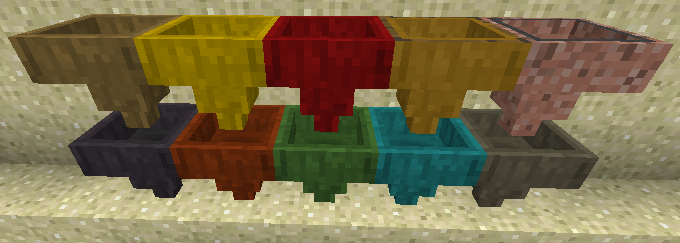
Hopper Configuration
 Example of smart hopper control slots.
Example of smart hopper control slots.
The heart of any smart hopper are its inventory control slots. You can see these slots in the pop-up window you get when you activate or right-click on a placed hopper. For a regular hopper, these slots are just regular item inventory slots; for smart hoppers, you get inventory slots as well as some new types of slots called control slots. Control slots define what a hopper will do exactly. A few of the smart hoppers will work like regular hoppers if you do not configure them; but most of them are pretty dumb until you use the control slots to tell them to do something smart.
Three Slots Types
Smart hopper inventory slots come in three flavors: input, output, and control. For some hoppers, a single slot can represent both input and output; for example, all of a fatty hopper's slots are both input and output slots as they can receive items (input) and dispense items (output) automatically. But for most smart hoppers, input slots are distinct from output slots and will only receive items pushed in from another source or manually placed by the player. Control slots are always separate from other slots and do not participate in any form of automated item flows; you must put and take items out of these slots manually always. Finally output slots, will only receive items generated by the hopper's processing and will most often (but not always) automatically push these items to the next hopper or inventory it points to.
Control Slots
![]()
![]()
![]() Examples of control slots
Examples of control slots
You configure a smart hopper by putting different kinds of items into one or more of its control slots. A control slot is always colored differently from regular inventory slots, is almost always the first one or two slots (from the top-left of the window), and can contain a little background glyph as a hint for what you can put there. Each hopper's control slot is described in its specific section.
Input Slots
![]()
![]()
![]()
![]() Examples of input slots
Examples of input slots
If a smart hopper includes input-only slots, they are indicated by special background glyphs that show where those slots are "fed" from. Just like a regular hopper, a smart hopper can be fed from one or more of its sides by another hopper, an inventory like a chest, or a redstone contraption like a dropper. Remember, input-only slots receive items only; these items will stay in the hopper's inventory until they are used by the hopper's processing.
Output Slots
![]()
![]()
![]()
![]() Examples of output slots
Examples of output slots
Most hoppers use the standard inventory slot appearance for output slots. However some output slots either contain special items (for example by-products like empty containers from auto-crafting) or are not pushed and must be pulled explicitly by another hopper. Like special input slots, these output slots usually contain a special background glyph.
Beyond Hoppers
![]()
In addition to the hoppers themselves, the Smart Hoppers mod includes several utility items for use with the hoppers or on their own. These are mostly simple single-purpose items, but some like the crafting tables have their own "smart" features.
- Line Crafting Table: is a crafting "station" table you hook into a bulk storage system directly.
- Hopper Plug: is a slab you place on a hopper to prevent it from slurping nearby floating items.
- Slot Plug: is an item that deactivates a smart hopper input or output slot.
- Deluxe Crafting Table: is a crafting table that stores items between uses.
- Pouches: early game item that lets you carry a few stacks per inventory slot.
- Generic and Player Keys: let you lock items like chests, shulker boxes, and dispensers.
- Wallets and LockBoxes: let you stash your preciouses in containers only you can open.
- Xp Food: lets you store and later consume xp like you would food or drink.
Hopper Shells
All of the smart hoppers are crafted from an item called a hopper shell. The shell represents the common bits of all smart hoppers and the final smart hopper is always a shell combined with other items unique to that hopper. A hopper shell is a little bit more resource expensive than a regular hopper — it requires a comparator and block of redstone in addition to five iron ingots and a chest. Note that you cannot place a hopper shell as a block; it is only useful for crafting the actual smart hopper.
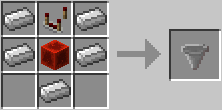 The foundation of all smart hoppers.
The foundation of all smart hoppers.
Iron Mesh
To reduce the additional iron needed to create a lot of smart hoppers (for instance a line of filtering hoppers for a sorting system), the mod includes an item, iron mesh or just mesh. You create mesh from iron bars and combine it, instead of iron ingots or iron bars, to craft the different types of filtering hoppers.
 An iron bar crafts to 4 pieces of mesh.
An iron bar crafts to 4 pieces of mesh.
Slot Plugs
Many of the smart hoppers include more than the typical five (5) hopper flow-through slots, making the issue of "lost" or wasted items in item sorting systems even worse potentially. You can effectively delete a smart hopper slot by placing a special mod item called a plug in the slot you want disappeared. Plugs work only with smart hoppers; if you place them in a vanilla hopper they'll just flow through like any other item. You cannot place a slot-plug in a smart hopper's control slot.
 Crafting a slot-plug requires iron-bars and slime!
Crafting a slot-plug requires iron-bars and slime!
Storage Hoppers
![]() +
+ ![]() Regular and heavy-duty or "eager" fatty hopper items.
Regular and heavy-duty or "eager" fatty hopper items.
Fatty hoppers give you back the chest inventory slots you lose crafting a hopper; they each have at least 27 slots like a small chest. Use a fatty hopper to combine a hopper and single chest into a one block space. Because they can hold a lot of items, you can use fatty hoppers as the collection hoppers in a water item transportation system for semi-automatic crop farms that produce lots of items in a short time.
The heavy-duty or "eager" fatty hoppers will consume up to 2-3 times the number of items in the same period as a regular hopper; this, plus their larger storage capacity means you're not going to lose any items to de-spawning even with very big farms. If you attach an eager hopper to a chest, it will push items into that chest at an increased rate as well.
Hopper Craft Recipes
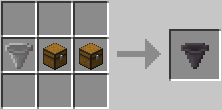 A fatty hopper from a shell and 2 chests.
A fatty hopper from a shell and 2 chests.
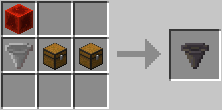 Eagerness requires a block of redstone!
Eagerness requires a block of redstone!
How To Use Fatty Hoppers (GUI)
Fatty hoppers are plain item containers with inventories the size of a single chest; there are no other controls or special slots in their interfaces. The heavy-duty fatty hopper's inventory is shaded different from a regular or plain fatty hopper so you can tell the difference when they're placed. All of fatty hoppers are a much darker gray than regular hoppers so you can spot them quickly in a mixed hopper chain.
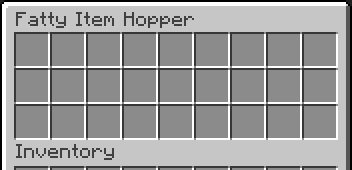 Get more slots of storage,…
Get more slots of storage,…
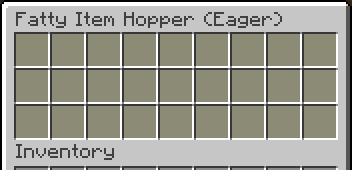 and a faster item pull-rate!
and a faster item pull-rate!
Testing Item-Slurping Rates
To check how much faster an eager fatty hopper is versus a regular hopper, you can setup an eager hopper, a regular hopper, two trapped chests and two regular chests like shown below. The darker hopper to the right is the eager one. Then put four (4) stacks of any block into the large trapped chest on top and close it. In a few seconds all the items will be drained out by the two hoppers; however, the fatty hopper should have pushed about 2 1/2 stacks into the chest, while the regular hopper would have pushed about 1 1/2 stacks. Use an eager++ hopper and the difference is even greater.
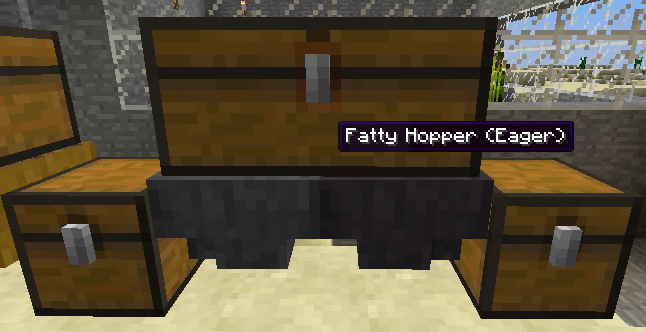
Useful Items To Pair With
- Line-crafting table to pull items from the table's output slots quickly (so player doesn't wait)
- T-Filter hopper to branch an item pipeline
- As the final hopper in a sorting system before the overflow chests or disposal hopper (buffer zone)
Jabba The Hopper
The Jabba hopper is a much larger capacity eager fatty hopper (3x) and it pulls more items at a rate even quicker than the eager hopper. Use it when you need a very large buffer at an intersection point of many high-volumes hopper lines.
Packing Hoppers
![]() +
+ ![]() +
+ ![]() Packer, un-packer, and packaging hopper items.
Packer, un-packer, and packaging hopper items.
This trio of hoppers help you to automatically create and un-create storage blocks like coal blocks, redstone blocks, and slime blocks. Packing hoppers are useful in automatic item storage systems as they let you store the block form of an item in the unseen secondary overflow chests while the main chest contains the regular item. By using a packer and un-packer to replace two regular hoppers in a typical storage system unit you can increase that unit's capacity 4-9 times.
Hopper Craft Recipes
 A packing hopper from a shell, sand block, and chest.
A packing hopper from a shell, sand block, and chest.
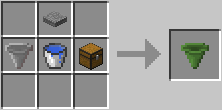 An unpacking hopper from a shell, water bucket, and chest.
An unpacking hopper from a shell, water bucket, and chest.
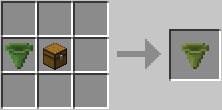 A heavy-duty unpacking hopper adds more output slots.
A heavy-duty unpacking hopper adds more output slots.
How To Use Packer Hopper (GUI)
For packers you need to select a packer recipe which describes the type and specific number of items or blocks to be packed. You select a particular recipe by placing a sample of its input items in the hopper's solid green control slot.
 A packer's GUI.
A packer's GUI.
How will you know that you've selected a packer recipe? Until the hopper recognizes the item combination as a valid packer recipe, its main title will show as purple; when you have a valid combination, the title turns to the normal dark gray.
 Defined to pack melon blocks.
Defined to pack melon blocks.
Packer recipes are different from your regular crafting recipes and they have to be pre-registered by mods for the hoppers to match your inputs to a specific output. However, you don't have to wait for mods to integrate with Smart-Hoppers to use packers– all of the vanilla Minecraft storage block recipes are registered as packer recipes automatically. Plus there is a config option you can enable to have SmartHoppers scan the recipe registry at startup to automatically pick out packer-friendly recipes from other mods (read details below).
![]() Pre-registered recipes.
Pre-registered recipes.
For automated packing, make sure the five (5) green input slots are fed with the items defined in the green control slot. Packers have a single output slot that collects the packed items. If the packing hopper is pointing into a another inventory (a chest, dropper, hopper, etc.), it will automatically try to push the packed items to that inventory. If there is a hopper below a packing hopper, it will pull items only from the output slot.
 A packer in action!
A packer in action!
Some packer recipes contain two different types of items: a primary item, and a secondary item that we call the packaging or binding item. The packer expects for every N of the primary item (usually 4, 6, or 8), the packer recipe uses one of the packaging item. To select one of these recipes, you need to put a sample of the packaging item in the solid blue control slot.
 Defined to pack using two items.
Defined to pack using two items.
For automated packing, make sure the blue input slot is supplied with the item defined in the blue control slot. Note that the blue input slot is fed from above ONLY while the green input slots can be fed from one or more sides.
 A packer in action!
A packer in action!
How to Use Un-Packer Hopper…Same As Packer…Kind-of
You setup un-packers the same way as packers; the un-packer simply does an automatic "undo" of the packer recipe you select. The big difference is that the un-packer will expect as its input, the output of the same recipe when defined in a packer. So, for the melon block packer example shown above, an un-packer would expect to receive as inputs melon blocks which it would unpack into 9 melon slices as its own output.
 An un-packer's GUI.
An un-packer's GUI.
 Defined to unpack melon blocks.
Defined to unpack melon blocks.
Because an un-packer can produce a lot of items quickly, you can use a large heavy-duty un-packer to increase the hopper's own output storage to 24 slots to get a nice buffer if the un-packer feeds into a regular hopper or chest. Both types of un-packers are lossless which means they will not unpack a storage block unless there is room for all of the resulting items in its output slots.
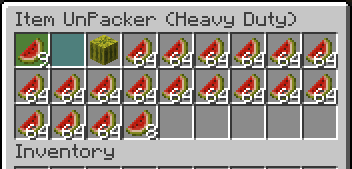 A heavy-duty un-packer in action!
A heavy-duty un-packer in action!
Automatic Packer Recipe Registration
All of the standard Minecraft storage item and block crafting recipes are pre-registered as packer recipes. Before v4, these built-in recipes were composed of only those items that are convertible from one form (unpacked) to the other (packed) and back again. So for instance, there was no packer recipe defined automatically to pack string into wool blocks or quartz into quartz blocks as these are not reversible in vanilla Minecraft. As of v4 and Minecraft 1.12, there are several exceptions to this general guideline; now you can pack items like string and glowstone dust.
![]()
If the built-in recipes do not include the storage blocks you want to make, you can also ask Smart-Hoppers to check all of your registered crafting recipes, including mod recipes, to see if there are any that would make valid packer recipes and automatically register them as such. To be valid the recipe would have to conform to the simple storage block pattern of the vanilla blocks. To turn this option on, run Minecraft at least once with Smart-Hoppers installed, exit, and edit the Smart-Hopper's configuration file as highlighted below for servers; for single player just use the mod configuration GUI screens.
"c recipes" {
# Set to true to enable auto-discovery of packer recipes.
B:auto_discover_storage_blocks=true
}
If your storage block recipes require two items or just don't conform to the simple storage block recipe, the owning mod must register a custom packer recipe through the Smart-Hoppers API.
 A custom mod-registered packer recipe.
A custom mod-registered packer recipe.
Packaging Maker
The packaging hopper is a simplified auto-crafter designed to work with packers in a bulk-crafting assembly line. You use a packaging hopper to mass produce the packaging or binding ingredient for a packer recipe to ensure your packing hopper does not run out of this required item and stop the production line.
Hopper Craft Recipes
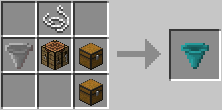 Crafting a packaging hopper.
Crafting a packaging hopper.
How To Use Packaging Hopper (GUI)
As with the packer and un-packer, you tell a packaging hopper what to produce by putting a sample of its recipe items in the hopper's control slots. The same limitations that apply to a packer recipe with regards to two-item recipes, apply here. In the simplest setup, you would attach a packaging hopper to the blue input slot of the packing hopper.
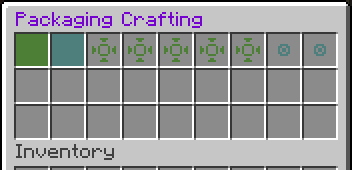 A packaging maker's GUI.
A packaging maker's GUI.
A packaging hopper has a large output inventory capacity so it can hold up to 18 stacks of its produced item. Typically, you supply enough ingredient items to ensure the packaging hopper's inventory is filled to capacity so your packer(s) will rarely, if ever, run out of the required item.
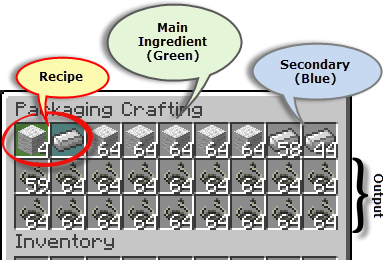 Custom packaging recipe.
Custom packaging recipe.
Vanilla Uses
It's possible to use a packaging maker to create a few simple vanilla items like paper, string, glass bottles, and bonemeal. In general though, packaging recipes are defined by third-party mods that integrate with Smart-Hoppers to register their multi-item packer recipes.
Instruction "Cards"
![]()
Many smart hoppers will let you put a special item called an instruction card in a control slot. An instruction card is a convenient way to identify a large(ish), usually heterogeneous, collection of items that a smart hopper needs to identify or manage in some way. Currently, there are three kinds of instruction cards: filter lists, recipe cards, and hopper command cards. Filter list cards can define a set of items the hopper blocks or they can define a set of items the hopper allows through. Recipe cards always define a specific combination of items for a selected version of a Minecraft recipe. Command cards change a hopper's core behavior and are accepted by only a few hoppers currently. How a card is interpreted is ultimately up to the specific hopper using it.
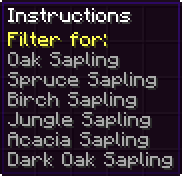
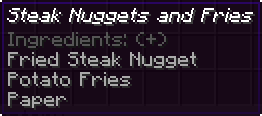
Example of a generic filtering list (left) and a recipe card (right) you might use with smart hoppers. When filter lists are used with disposal and recycling hoppers, we call them keep lists because they indicate what items the hopper should pass through or keep untouched.
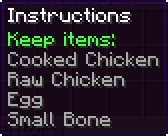 A "keep list" for a nano-chicken farm's disposal hopper.
A "keep list" for a nano-chicken farm's disposal hopper.
Instruction Stamps Craft Recipes
You create an instruction card by "stamping" the selected items' information unto a piece of paper using a special crafting table called a slot card crafting table. First you need to create the particular kind of stamp you want to use. Even though there are two basic kinds of cards, we provide several different stamps to help you create useful tool-tips to identify what is on a card once it's created (all instruction cards kinda look like pieces of paper so the additional tool-tip information is pretty useful).
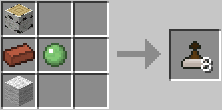 Create a set of stamp blanks. Any log or wool block works.
Create a set of stamp blanks. Any log or wool block works.
Once you've got a set of stamp blanks, you can create the specific kind of stamp to match your intended instruction. You cannot use stamp blanks to create instruction cards; you must specify what the information on the card describes as this lets the crafting table determine how to describe the items to the smart hopper so it matches your selection criteria as accurately as possible.
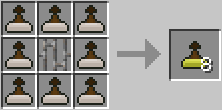 Create a set of "Filter for:" stamps. You can use mesh instead of iron-bars.
Create a set of "Filter for:" stamps. You can use mesh instead of iron-bars.
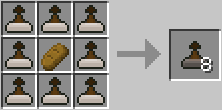 Create a set of "Recipe ingredients" stamps. Any "foodBread" item works.
Create a set of "Recipe ingredients" stamps. Any "foodBread" item works.
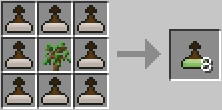 Create a set of "Keep items:" stamps for disposal hoppers. Any sapling works.
Create a set of "Keep items:" stamps for disposal hoppers. Any sapling works.
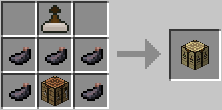 Finally, make the slot card crafting table to create your custom instruction cards.
Finally, make the slot card crafting table to create your custom instruction cards.
How To Use Slot Card Crafting Table (GUI)
You put the items you want included on the instruction card into the "Selection" 3×3 grid. If you're creating a recipe card, make sure you define a known craft recipe by checking the result preview item that shows the current match for the items you've placed, just like a standard crafting table. For other types of cards, this recipe preview slot really doesn't matter.
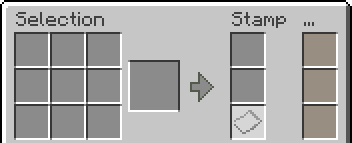 Empty slot card crafting table's GUI.
Empty slot card crafting table's GUI.
Next, put the stamp that matches the type of card you're making into the top "Stamp" slot, and a piece of paper into the second slot (below the stamp). If the table can create a valid instruction card with the current combination of items, it will generate the card and place it in the bottom-most Stamp slot, the one with the light card outline, for you to pick up. You do not lose the selection items when you create an instruction card; only the stamp and the paper gets consumed for the card.
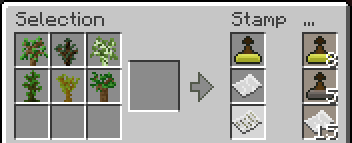 Defining a filter list for a variety of saplings.
Defining a filter list for a variety of saplings.
You can use the three rightmost "…" slots for storage of extra stamp supplies as shown in the picture above. These items will be kept by the table between crafting sessions. Note that items on the crafting areas ('Selection' and 'Stamp') are ejected just like they are for a standard crafting table.
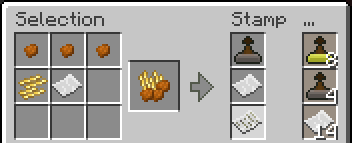 Stamping ingredients for nuggets and fries!
Stamping ingredients for nuggets and fries!
 Defining a keep list for a disposal hopper.
Defining a keep list for a disposal hopper.
Wildcard Option
To create an instruction card that describes items that have sub-types (like multi-colored blocks) or can take damage (like tools), you can use an Options stamp. The options stamp lets you create a piece of paper pre-stamped with a "match any" instruction for the slot card crafting table to detect.
Options Stamp
To create a pre-stamped "match any" piece of paper, create an Options stamp and apply it to a plain piece of paper. Both actions are done on a regular crafting table.
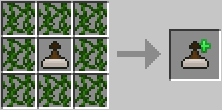 Crafting a wildcard stamp from a regular stamp blank.
Crafting a wildcard stamp from a regular stamp blank.
 Gives
Gives ![]() Pre-stamped paper.
Pre-stamped paper.
Unfortunately, pre-stamped paper looks like regular paper because it is just paper but with some special information attached to that particular instance. To help you keep track of your pre-stamped paper, the item tool-tip is changed as shown above. To create a filter list, just put the pre-stamped paper where you would normally put a plain piece of paper and you'll get a match-any filter list.
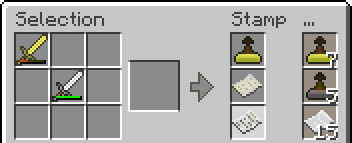 Gives
Gives 
Hoppers That Accept Instruction Cards
If a smart hopper accepts instruction cards in a control slot, that slot's four corners will be highlighted with a yellow border. If a control slot accepts only instruction cards, its background with contain a card glyph as shown below.
![]()
![]() Accepts instruction card or other items as defined by the hopper.
Accepts instruction card or other items as defined by the hopper.
![]() Accepts only instruction cards.
Accepts only instruction cards.
Having More Than Nine Items Per Card
The slot card crafter's 3×3 "Selection" grid lets you select at most nine (9) items for inclusion on an instruction card. This limitation is fine for recipe cards as you cannot create a recipe with more items from a standard Minecraft crafting table. However, for filter lists, you might need to specify more items. You create larger lists by combining smaller lists — up to a max of 27 underlying items (or a single chest's size of slots). You can combine lists once (i.e. you cannot create lists of lists of lists…) on the slot card crafting table. You can also use named lists to refer to very long lists of items; read the "Filtering Hoppers" section for more information on named lists.
Example: Merging two filter lists for Sandstone items
Lets say we want to create a filter list that allows the sandstone items we use together most frequently. This list will include at least five items from the yellow sandstone group, and five from the red sandstone group. Because that is at least 10 items, we need to create a combined filter list as the basic 3×3 "Selection" grid only holds nine items. The steps below demonstrate one way to make a combined filter list card:
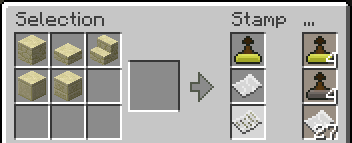 a: Create filter list for sandstone items.
a: Create filter list for sandstone items.
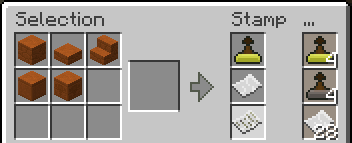 b: Create filter list for red sandstone items.
b: Create filter list for red sandstone items.
The next step is optional but highly recommended as it makes recalling what's on a combined list easier (the combined list's tool-tip list will show the names of the inner lists not their contents).
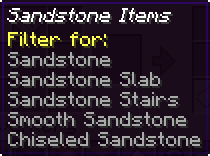 c: Use an anvil to give each filter list a useful name.
c: Use an anvil to give each filter list a useful name.
To create a combined list instruction card, you need to use the smaller filter list cards as the selected items on the slot crafting table for the new combined list. Remember you don't lose the items you put on the "Selection" grid, so you can reuse the smaller lists to create other combinations at another time.
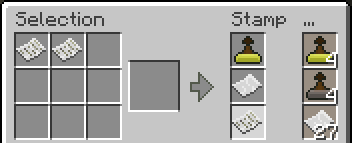 d: Create the combined filter list.
d: Create the combined filter list.
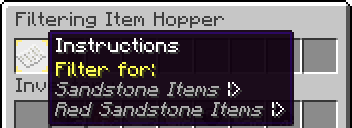 e: Use the new instruction card as usual.
e: Use the new instruction card as usual.
Remember Options Stamps
If you want to specify all the varieties of a single item on a card, it's much easier to use an Options stamp to create a "match any" instruction rather than create a bunch of partial lists.
Filtering Hoppers
![]() +
+ ![]() +
+ ![]() Filter, T-Filter, and T1-Filter hopper items.
Filter, T-Filter, and T1-Filter hopper items.
Filtering hoppers let you define what items should pass through a hopper and to varying degrees how those items pass through. Filtering hoppers are the original smart-hoppers– they're an all-in-one replacement for the hopper + comparator + redstone + repeater + torch "unit" we use for most item filtering and sorting systems. There are three types of filtering hoppers: a simple Filter hopper, a T-Filter hopper, and a T1-Filter hopper. The one you choose depends on the type of sorting system you're constructing.
Filter Hopper
The plain filter hopper is the most straightforward– if an item matches its filter criteria, the hopper allows it into its inventory, to any suitable slot, and the item is pushed or pulled just like a normal hopper behaves. A filter hopper is not part of your main hopper pipeline but is usually fed by it.
Hopper Craft Recipes
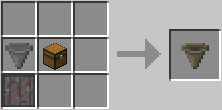 Crafting a filter hopper from a shell and slot-plug.
Crafting a filter hopper from a shell and slot-plug.
How To Use Filter Hopper (GUI)
You control what item a filter hopper allows into its inventory by putting a sample of the allowed item into its control slot. To allow more than one type of item, use a filter list (read the "Instruction Cards" section, see below). To allow any item to pass through, leave the control slot blank. To prevent any items from passing through, use an empty filter list.
 A filter's default GUI; all items allowed!
A filter's default GUI; all items allowed!
 Defined to allow only oak saplings.
Defined to allow only oak saplings.
You can use any kind of instruction card in a filtering hopper's control slot so long as the card defines a list of items that the hopper can match against. This includes regular lists, composite lists, keep lists, wildcard lists, and named lists.
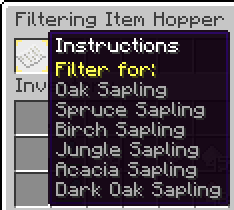 Allows any standard tree saplings through.
Allows any standard tree saplings through.
Named Lists
If you're using this mod, chances are you've installed other mods some of which extend the selection of standard items; for instance, by adding new trees and sapling types. To filter for all items that belong to a particular category, you can put a by-name filter list (items are selected based on their Forge registry name) in the hopper's control slot. This setup is useful to get a basic level of type-sorting without having to create too many specific filter lists. Smart Hoppers also supplies a set of special pre-named composite categories for you to use and extend. Some of the composite categories include: "Animal Drops", "Tree Drops", "Crops", "Ores", "Seeds", "Hostile Drops", "Buckets", etc.
 Allows any kind of tree sapling.
Allows any kind of tree sapling.
Too Many Slots (Of Waste)!
The filter hopper's inventory is almost twice as large as a regular hopper's. This is a bad thing if you want to limit the amount of items "stuck" in the pipeline and not accessible to the player. Use the Smart Hopper slot plug item to block off any unwanted inventory slots.
 Set to just two inventory slots!
Set to just two inventory slots!
Common Uses
- As an all-in-one replacement for the filtering unit in a standard sorting system.
- Pair with a disposal hopper in chicken and cow cookers to be rid of unused drops like feathers.
- Combine with slot-plugs to create a smaller capacity "regular" hopper.
- To add a simple type-based organization to overflow storage chests.
T-Filter Hopper
The t-filter hopper lets you split the incoming items into two groups: matched and unmatched. The unmatched items are pushed by the hopper according to how you position it; so for instance, you could push the unmatched items further down the item sorting pipeline to the next filter. The matched items are put into a set of output slots that must be pulled from below by another hopper, usually another t-filter hopper or a eager fatty hopper if you're creating a branched pipeline. A t-filter hopper is usually inserted directly into your main hopper pipeline.
Hopper Craft Recipes
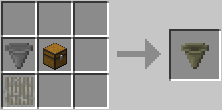 Crafting a t-filter hopper from a shell and mesh (you can also use iron bars).
Crafting a t-filter hopper from a shell and mesh (you can also use iron bars).
How To Use T-Filter Hopper (GUI)
You define a t-filter the same way you define a simple filter hopper– put either a single sample item into its control slot or more typically, for multiple types of items, a filter list instruction card. If an item matches the filter criteria it is put into the matched inventory (four slots to the right) to be pulled by another hopper, if not, the item is put into the unmatched inventory (four slots to the left) and pushed where-ever the hopper is pointed.
 An undefined t-filter hopper.
An undefined t-filter hopper.
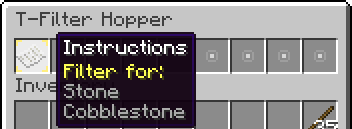 Defined to filter for smooth and cobble stone.
Defined to filter for smooth and cobble stone.
To demonstrate how the filtered items are split, below is an example set of items that we can pass through a t-filter setup as above. Note that there are matching items and non-matching items in the test inputs.
 Example test inputs for filter setup above.
Example test inputs for filter setup above.
As the items are passed through the t-filter, items are sorted into the matched or unmatched inventories. The dirt items would normally be pushed on to the next hopper in the pipeline (for this demonstration, there are no attached hoppers or chests to the test hopper so all the items sit in the t-filter's inventories).
 Items queued in their inventories.
Items queued in their inventories.
 Close to done.
Close to done.
Now all of the matching items (smooth stone and cobble stone) are in the right slots. These would be drained by another hopper situated below this hopper and either sent off to another sorting system or stored. All of the unmatched items (dirt, redstone, coal) are in the left slots, waiting to be pushed on the next filtering hopper.
Common Uses
- Use to branch a single incoming item source into two parallel pipelines. For example, if you have a water collection and transport system that collects items from many farms into a common storage area, you can branch the water system at the point it enters your sorting system so categories of items can be sorted in parallel.
- Use several t-filter hoppers to create dropper-less, compact multi-item sorting and storage system. The topmost t-filter hopper (part of the item pipeline) needs a filter list of all the possible items for the entire column so that anything not belonging to that column continues through the pipeline to the next filter.
T1-Filter Hopper
The t1-filter hopper is a refinement of the t-filter hopper that lets you handle item overflow situations gracefully. The smart hopper will limit each item in the filter list to a single slot, so in the event of overflow of one item, the flow of other types of items is not adversely affected. A T1-Filter hopper is usually inserted directly into your main hopper pipeline.
Hopper Craft Recipes
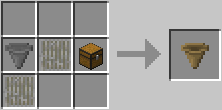 Crafting a t1-filter hopper from a shell and mesh (you can also use iron bars).
Crafting a t1-filter hopper from a shell and mesh (you can also use iron bars).
How To Use T1-Filter Hopper (GUI)
To use a t1-filter hopper, you must supply a filter list instruction card that contains at most 9 items. The hopper uses this list to allow items into its inventory just like a t-filter. The t1-filter's matching items inventory is so large to allow you to use a single hopper to fill a single chest with up to 9 different items (3 slots per item type).
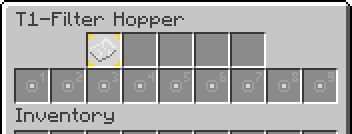 An undefined t1-filter hopper.
An undefined t1-filter hopper.
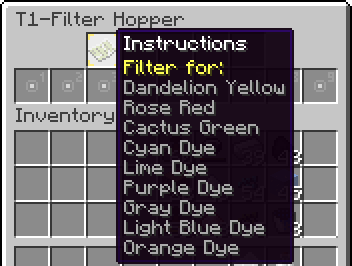 Allows up to 9 different items.
Allows up to 9 different items.
How T1-Filter Differs from T-Filter
Below is a screenshot of the problem the t1-filter is designed to alleviate. In this example, a t-filter is used to sort mob-drops into a vertical multi-item storage system where each chest contains two or more types of items. Imagine a column of three chests, with each chest fed by a t-filter that ensures it receives only items that belong to that chest.
As you see below, with a regular t-filter if there is an overflow of one or more of the items in the hopper column, the backed up slots will eventually block all of the item slots in the entire column, even the ones that do have space in their chests. A t1-filter prevents this from happening provided the downstream pipeline remains unclogged.
 Redstone and glowstone dust now blocked by backed up sticks and sugar…
Redstone and glowstone dust now blocked by backed up sticks and sugar…
 T1-filter limits sticks and sugar to one slot each so others can still flow even when there is no more room for sugar or sticks. The extra sticks and sugar are put in the unmatched inventory and pushed down the filter pipeline (perhaps to an overflow silo or disposal).
T1-filter limits sticks and sugar to one slot each so others can still flow even when there is no more room for sugar or sticks. The extra sticks and sugar are put in the unmatched inventory and pushed down the filter pipeline (perhaps to an overflow silo or disposal).
Disposal Hoppers
![]() +
+ ![]() Recycling and Disposal hopper items.
Recycling and Disposal hopper items.
Disposal hoppers let you zap stuff in an efficient, automated way. They're very useful for mob-farms, large mining operations, and just getting rid of the mass of junk we accumulate after awhile. They're a lot safer to install and use than a lava pit and have a builtin safety mechanism in case you accidentally shift-click that precious beacon into your disposal system.
Disposal Hopper
A pure disposal hopper works by default the way you'd expect: you pipe items into the hopper and those items go *poof*! A global "always keep" list provides a safety catch for rare items like beacons and golden apples and you can adjust this global list or give each hopper a unique keep list with an instruction card.
Hopper Craft Recipes
 Crafting a disposal hopper from a shell and lava bucket. You can use a cactus block instead of a lava bucket.
Crafting a disposal hopper from a shell and lava bucket. You can use a cactus block instead of a lava bucket.
How To Use Disposal Hopper (GUI)
A disposal hopper doesn't need any additional configuration to destroy items; generally it will disappear anything you put into its input inventory. A disposal hopper has a set of output slots (the rightmost three) to handle "always keep" items that you define. If one of these to-be-kept items is fed to the disposal hopper it is moved to an output slot to be piped wherever you've pointed the disposal hopper (usually back into your sorting system or to a "whoopsies" chest).
 Plain disposal hopper GUI.
Plain disposal hopper GUI.
The default global keep list contains items we consider rare enough that it's likely a mistake that the player dropped it in the disposal (items like nether stars, beacons, golden apples, gem blocks, diamond horse armor, etc). The complete list is shown at end of the section and you can extend it by changing the mod's config file. To add kept items to a specific disposal hopper, you can create a keep list instruction card and put it in the disposal's control slot. Note that your keep list is in addition to the global list.
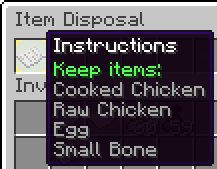 Defined with a keep list instruction card.
Defined with a keep list instruction card.
 Moving "always keep" items to output slots.
Moving "always keep" items to output slots.
Global Keep List (Default)
Both disposals and recycling hoppers check this list before destroying or in the case of a recycler, recycling any item fed to it. Some of these item cannot be removed from the global list; many are defined in the mod's config file (where you can remove or extend the list).
- Nether Stars
- Beacons
- All gems, ingots, and their ore and storage blocks
- Golden apples (both kinds)
- Diamond horse armor
- Totems
- Sponges (wet and dry)
- Ghast tears
- Ender chests
- Wither skeleton skulls
- Shulker shells
- Slime blocks
- Coal blocks
- Speckled melon
- Golden carrots
Recycling Hoppers
A recycling hopper is a specialized disposal hopper; before destroying an item, it will check it against a list of recycle recipes to see if the item can be reduced back to a basic material instead. For example, if you recycle a hopper, you can get back two or three pieces of iron. There are recycle recipes for many vanilla items and mods can register their own using the Smart Hopper API.
Hopper Craft Recipes
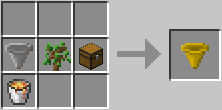 Crafting a recycling hopper.
Crafting a recycling hopper.
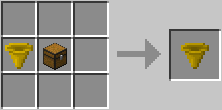 A heavy-duty recycling hopper adds more slots!
A heavy-duty recycling hopper adds more slots!
How To Use Recycling Hopper (GUI)
On first glance, a recycling hopper seems to work identically to a disposal hopper. And if you don't feed in any items that it can recycle, it works exactly like a pure disposal hopper– all incoming items are disposed of permanently. The fun begins when you put in an item that matches a recycle recipe. Make sure you setup a recycler so that the recycled materials feed back into your sorting system or go into a large enough overflow chest system.
 Plain recycling hopper GUI.
Plain recycling hopper GUI.
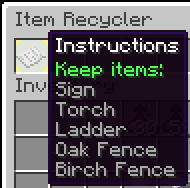 Defined with a keep list instruction card.
Defined with a keep list instruction card.
 Recycling hopper in action!
Recycling hopper in action!
Example Vanilla Recycle Recipes
This is not the complete list of recycle recipes as the full list is too long to include here, but this list of common uses should give you an idea of how the recipes work. The recipes always convert from a refined (or 'finished') item to a single base material. You never get back all (or even most) of the materials you used to create the input item; but some is better than none! You'll need to experiment to discover what items recycle and to what basic materials. Remember a recycling hopper will not recycle or destroy any item on the global keep list (see the disposal hopper section for the default list); those items are moved to the output slots untouched.
- Bucket (any) -> 2 iron ingots
- Hopper -> 4 iron ingots
- Iron door -> 2 iron ingots
- Plain iron rail -> 2 iron nuggets (if available!)
- Golden rail -> 1 gold ingot
- Gold sword (any damage) -> 3 gold nuggets
- Diamond chest plate (any damage) -> 1 diamond
- Comparator -> 1 piece quartz
- Quartz block -> 3 pieces quartz
- Wool block (any) -> 3 pieces string
- Redstone lamp -> 3 pieces glowstone dust
- 1 TNT block -> 3 pieces gunpowder
- Stone brick block (any) -> 1 smooth stone block
- Anvil (any damage) -> 2 iron blocks
- Stained clay block -> 2 clay balls
- Prismarine brick block -> 8 prismarine shards
Using a Heavy-Duty Recycling Hopper
A heavy duty recycling hopper has a greater input and output inventory capacity compared to the regular hopper. Aside from this, it is identical in function and how you configure it.
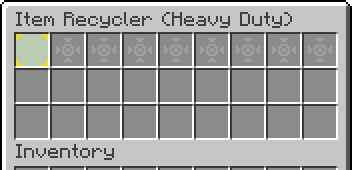 Heavy-duty recycler's GUI.
Heavy-duty recycler's GUI.
You can use a heavy duty recycling hopper if you don't have a big sorting system to feed items back into. The hopper's larger output capacity captures more types of material in one place for you to retrieve manually.
You can use a heavy-duty recycling hopper if you're recycling a lot of non-stackable items. The hopper's larger input capacity helps to prevent your hopper from clogging as slots are taken by single items.
Finally, use a heavy duty recycler if you're feeding the hopper from multiple sources. Again, the larger input and output inventories will help to prevent the hopper inputs from backing up possibly into your item pipeline.
Auto-craft Hoppers
![]() +
+ ![]() Lightweight and heavy duty auto-crafting hopper items.
Lightweight and heavy duty auto-crafting hopper items.
General purpose auto-crafting hoppers let you automate the crafting of a single specific recipe. They are useful for shops and quickly producing large amounts of an item for building projects. Think of them like those automated cookers (chicken, steak, etc.) but for any recipe, not just a farm mob's drops.
Technically many of the smart hoppers are auto-crafters as they automate the crafting of various kinds of items. What makes these hoppers different is that they do not impose any restrictions on the recipes they can process and the items they can produce provided you supply them with all the required input items.
Hopper Craft Recipes
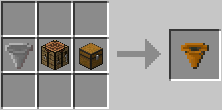 Crafting a 2×2 auto-crafting hopper.
Crafting a 2×2 auto-crafting hopper.
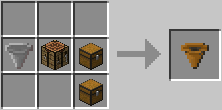 Crafting a 3×3 auto-crafting hopper.
Crafting a 3×3 auto-crafting hopper.
How To Use Auto-Crafting Hopper (GUI)
You must supply a valid recipe instruction card for the auto-crafting hopper to produce something. Until then, the GUI's main label is drawn in purple to signal the hopper is not properly configured. A valid recipe card displays the produced item's name and displays a "(+)" next to the "Ingredients" list in the card's tool-tip. Read the "Instructions Card" section to learn how to create a recipe card.
 Undefined 2×2 auto-crafter's GUI.
Undefined 2×2 auto-crafter's GUI.
For the 2×2 crafting hopper, there are four ingredient input slots that are fed from other sources, three output slots for produced items, and one special recycle slot to capture any by-products left over from using an input item. In vanilla Minecraft, the most common by-product item is an empty bucket from recipes that use buckets of liquids like milk or water. The contents of this recycle output slot can only be pulled from below by a smart disposal or conduit hopper. Of course the player can also remove items manually.
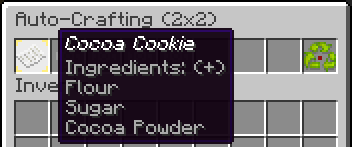 Defined with a valid recipe card.
Defined with a valid recipe card.
Usually a 2×2 auto-crafter is enough to craft most recipes — even ones that take up more than four slots on a regular crafting table. Because the smart hopper coalesces the ingredients by type, even if a shaped recipe occupies more than 4 craft table slots, it will work fine in the 2×2 auto-crafter if there are at most four unique ingredients. So for instance, something like a chest which takes up eight slots on the crafting table, actually only takes up one slot in the auto-crafter. For those times when you do have more than 4 unique ingredients, you can use a heavy duty auto-crafting hopper which allows up to 8 unique slots.
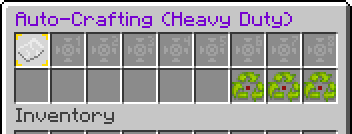 Undefined '3×3' auto-crafter's GUI
Undefined '3×3' auto-crafter's GUI
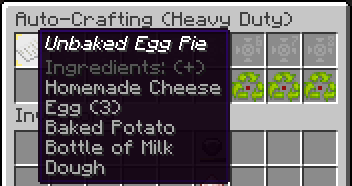 A recipe with more than 4 unique ingredients.
A recipe with more than 4 unique ingredients.
 Each ingredient is assigned to a single slot.
Each ingredient is assigned to a single slot.
Another reason to use the larger auto-crafter is if your recipe generates more than one by-product item or generates a by-product that doesn't support full 64-sized stacks. For example, your recipe generates an empty bucket and some other custom mod container item. The larger auto-crafter can handle up to three unique by-product items in its recycle slots.
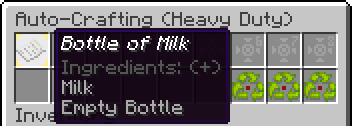 A recipe that generates lots of empty buckets!
A recipe that generates lots of empty buckets!
Things To Remember
- A recipe card reflects a specific version of a recipe — the exact one shown in the crafting grid when the card was stamped. If a mod's recipe supports substitutions (for example "any kind of wool block"), the mod actually registers N different versions of its recipe with Minecraft; one for each variation. When you create a card, you're selecting a specific one!
- If your recipe does generate by-product items it's possible that those items will be lost. Although the auto-crafter tries to capture such items to its recycle slots, it will discard an item if there is no slot available.
- Auto-crafters are lossless, which means they will stop crafting if there isn't enough room in its output inventory for all of the resulting items.
- An auto-crafter's outbound redstone signal strength is based on all of its slots including the recycle slots.
Other Types of Auto-crafters
The mod contains a few specialized auto-crafters. Read the sections above for information about the storage block packer and un-packer auto-crafters. The remaining auto-crafting hoppers are described in the spoilers below.
Hopper Craft Recipes
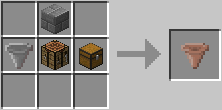 Crafting a block finishing hopper.
Crafting a block finishing hopper.
How To Use Block Finishing Hopper (GUI)
For block finishing you need to select a finishing recipe which describes the blocks to be finished. You select a particular recipe by placing a sample of its input items in the hopper's solid green control slot. When the hopper recognizes the inputs as a match to a finishing recipe, its label turns from purple to the normal dark gray color.
 Undefined block finishing GUI.
Undefined block finishing GUI.
Smart Hopper mod pre-installs all of the vanilla block finishing recipes automatically. So for instance, you can finish smooth stone into stone brick blocks, diorite and granite into their polished versions, wood logs into planks, etc.
 Defined to make polished diorite blocks.
Defined to make polished diorite blocks.
 Auto-crafting lots of nether brick blocks!
Auto-crafting lots of nether brick blocks!

![minecraft mod SmartHoppers-Mod [FORGE]](https://files.minecraftpatch.com/addons_new/smarthoppers-mod-forge-242112/screenshots/smarthoppers-mod-forge-scr-1-mini.png)
 Get 0.05 TON 💎
Get 0.05 TON 💎![SmartHoppers-Mod [FORGE]](https://files.minecraftpatch.com/addons_new/smarthoppers-mod-forge-242112/screenshots/smarthoppers-mod-forge-scr-2-mini.png)
![SmartHoppers-Mod [FORGE]](https://files.minecraftpatch.com/addons_new/smarthoppers-mod-forge-242112/screenshots/smarthoppers-mod-forge-scr-3-mini.png)
![SmartHoppers-Mod [FORGE]](https://files.minecraftpatch.com/addons_new/smarthoppers-mod-forge-242112/screenshots/smarthoppers-mod-forge-scr-4-mini.png)
![SmartHoppers-Mod [FORGE]](https://files.minecraftpatch.com/addons_new/smarthoppers-mod-forge-242112/screenshots/smarthoppers-mod-forge-scr-5-mini.png)
![SmartHoppers-Mod [FORGE]](https://files.minecraftpatch.com/addons_new/smarthoppers-mod-forge-242112/screenshots/smarthoppers-mod-forge-scr-6-mini.png)
![SmartHoppers-Mod [FORGE]](https://files.minecraftpatch.com/addons_new/smarthoppers-mod-forge-242112/screenshots/smarthoppers-mod-forge-scr-7-mini.png)
![SmartHoppers-Mod [FORGE]](https://files.minecraftpatch.com/addons_new/smarthoppers-mod-forge-242112/screenshots/smarthoppers-mod-forge-scr-8-mini.png)
![SmartHoppers-Mod [FORGE]](https://files.minecraftpatch.com/addons_new/smarthoppers-mod-forge-242112/screenshots/smarthoppers-mod-forge-scr-9-mini.png)
![SmartHoppers-Mod [FORGE]](https://files.minecraftpatch.com/addons_new/smarthoppers-mod-forge-242112/screenshots/smarthoppers-mod-forge-scr-10-mini.png)
![SmartHoppers-Mod [FORGE]](https://files.minecraftpatch.com/addons_new/smarthoppers-mod-forge-242112/screenshots/smarthoppers-mod-forge-scr-11-mini.png)
![SmartHoppers-Mod [FORGE]](https://files.minecraftpatch.com/addons_new/smarthoppers-mod-forge-242112/screenshots/smarthoppers-mod-forge-scr-12-mini.png)
![SmartHoppers-Mod [FORGE]](https://files.minecraftpatch.com/addons_new/smarthoppers-mod-forge-242112/screenshots/smarthoppers-mod-forge-scr-13-mini.png)
![SmartHoppers-Mod [FORGE]](https://files.minecraftpatch.com/addons_new/smarthoppers-mod-forge-242112/screenshots/smarthoppers-mod-forge-scr-14-mini.png)
![SmartHoppers-Mod [FORGE]](https://files.minecraftpatch.com/addons_new/smarthoppers-mod-forge-242112/screenshots/smarthoppers-mod-forge-scr-15-mini.png)
![SmartHoppers-Mod [FORGE]](https://files.minecraftpatch.com/addons_new/smarthoppers-mod-forge-242112/screenshots/smarthoppers-mod-forge-scr-16-mini.png)
![SmartHoppers-Mod [FORGE]](https://files.minecraftpatch.com/addons_new/smarthoppers-mod-forge-242112/screenshots/smarthoppers-mod-forge-scr-17-mini.png)
![SmartHoppers-Mod [FORGE]](https://files.minecraftpatch.com/addons_new/smarthoppers-mod-forge-242112/screenshots/smarthoppers-mod-forge-scr-18-mini.png)
![SmartHoppers-Mod [FORGE]](https://files.minecraftpatch.com/addons_new/smarthoppers-mod-forge-242112/screenshots/smarthoppers-mod-forge-scr-19-mini.png)
![SmartHoppers-Mod [FORGE]](https://files.minecraftpatch.com/addons_new/smarthoppers-mod-forge-242112/screenshots/smarthoppers-mod-forge-scr-20-mini.png)
![SmartHoppers-Mod [FORGE]](https://files.minecraftpatch.com/addons_new/smarthoppers-mod-forge-242112/screenshots/smarthoppers-mod-forge-scr-21-mini.png)
![SmartHoppers-Mod [FORGE]](https://files.minecraftpatch.com/addons_new/smarthoppers-mod-forge-242112/screenshots/smarthoppers-mod-forge-scr-22-mini.png)
![SmartHoppers-Mod [FORGE]](https://files.minecraftpatch.com/addons_new/smarthoppers-mod-forge-242112/screenshots/smarthoppers-mod-forge-scr-23-mini.png)
![SmartHoppers-Mod [FORGE]](https://files.minecraftpatch.com/addons_new/smarthoppers-mod-forge-242112/screenshots/smarthoppers-mod-forge-scr-24-mini.png)
![SmartHoppers-Mod [FORGE]](https://files.minecraftpatch.com/addons_new/smarthoppers-mod-forge-242112/screenshots/smarthoppers-mod-forge-scr-25-mini.png)
![SmartHoppers-Mod [FORGE]](https://files.minecraftpatch.com/addons_new/smarthoppers-mod-forge-242112/screenshots/smarthoppers-mod-forge-scr-26-mini.png)
![SmartHoppers-Mod [FORGE]](https://files.minecraftpatch.com/addons_new/smarthoppers-mod-forge-242112/screenshots/smarthoppers-mod-forge-scr-27-mini.png)
![SmartHoppers-Mod [FORGE]](https://files.minecraftpatch.com/addons_new/smarthoppers-mod-forge-242112/screenshots/smarthoppers-mod-forge-scr-28-mini.png)
![SmartHoppers-Mod [FORGE]](https://files.minecraftpatch.com/addons_new/smarthoppers-mod-forge-242112/screenshots/smarthoppers-mod-forge-scr-29-mini.png)
![SmartHoppers-Mod [FORGE]](https://files.minecraftpatch.com/addons_new/smarthoppers-mod-forge-242112/screenshots/smarthoppers-mod-forge-scr-30-mini.png)
![SmartHoppers-Mod [FORGE]](https://files.minecraftpatch.com/addons_new/smarthoppers-mod-forge-242112/screenshots/smarthoppers-mod-forge-scr-31-mini.png)
![SmartHoppers-Mod [FORGE]](https://files.minecraftpatch.com/addons_new/smarthoppers-mod-forge-242112/screenshots/smarthoppers-mod-forge-scr-32-mini.png)
![SmartHoppers-Mod [FORGE]](https://files.minecraftpatch.com/addons_new/smarthoppers-mod-forge-242112/screenshots/smarthoppers-mod-forge-scr-33-mini.png)
![SmartHoppers-Mod [FORGE]](https://files.minecraftpatch.com/addons_new/smarthoppers-mod-forge-242112/screenshots/smarthoppers-mod-forge-scr-34-mini.png)
![SmartHoppers-Mod [FORGE]](https://files.minecraftpatch.com/addons_new/smarthoppers-mod-forge-242112/screenshots/smarthoppers-mod-forge-scr-35-mini.png)
![SmartHoppers-Mod [FORGE]](https://files.minecraftpatch.com/addons_new/smarthoppers-mod-forge-242112/screenshots/smarthoppers-mod-forge-scr-36-mini.png)
![SmartHoppers-Mod [FORGE]](https://files.minecraftpatch.com/addons_new/smarthoppers-mod-forge-242112/screenshots/smarthoppers-mod-forge-scr-37-mini.png)
![SmartHoppers-Mod [FORGE]](https://files.minecraftpatch.com/addons_new/smarthoppers-mod-forge-242112/screenshots/smarthoppers-mod-forge-scr-38-mini.png)
![SmartHoppers-Mod [FORGE]](https://files.minecraftpatch.com/addons_new/smarthoppers-mod-forge-242112/screenshots/smarthoppers-mod-forge-scr-39-mini.png)
![SmartHoppers-Mod [FORGE]](https://files.minecraftpatch.com/addons_new/smarthoppers-mod-forge-242112/screenshots/smarthoppers-mod-forge-scr-40-mini.png)
![SmartHoppers-Mod [FORGE]](https://files.minecraftpatch.com/addons_new/smarthoppers-mod-forge-242112/screenshots/smarthoppers-mod-forge-scr-41-mini.png)
![SmartHoppers-Mod [FORGE]](https://files.minecraftpatch.com/addons_new/smarthoppers-mod-forge-242112/screenshots/smarthoppers-mod-forge-scr-42-mini.png)
![SmartHoppers-Mod [FORGE]](https://files.minecraftpatch.com/addons_new/smarthoppers-mod-forge-242112/screenshots/smarthoppers-mod-forge-scr-43-mini.png)
![SmartHoppers-Mod [FORGE]](https://files.minecraftpatch.com/addons_new/smarthoppers-mod-forge-242112/screenshots/smarthoppers-mod-forge-scr-44-mini.png)
![SmartHoppers-Mod [FORGE]](https://files.minecraftpatch.com/addons_new/smarthoppers-mod-forge-242112/screenshots/smarthoppers-mod-forge-scr-45-mini.png)
![SmartHoppers-Mod [FORGE]](https://files.minecraftpatch.com/addons_new/smarthoppers-mod-forge-242112/screenshots/smarthoppers-mod-forge-scr-46-mini.png)
![SmartHoppers-Mod [FORGE]](https://files.minecraftpatch.com/addons_new/smarthoppers-mod-forge-242112/screenshots/smarthoppers-mod-forge-scr-47-mini.png)
![SmartHoppers-Mod [FORGE]](https://files.minecraftpatch.com/addons_new/smarthoppers-mod-forge-242112/screenshots/smarthoppers-mod-forge-scr-48-mini.png)
![SmartHoppers-Mod [FORGE]](https://files.minecraftpatch.com/addons_new/smarthoppers-mod-forge-242112/screenshots/smarthoppers-mod-forge-scr-49-mini.png)
![SmartHoppers-Mod [FORGE]](https://files.minecraftpatch.com/addons_new/smarthoppers-mod-forge-242112/screenshots/smarthoppers-mod-forge-scr-50-mini.png)
![SmartHoppers-Mod [FORGE]](https://files.minecraftpatch.com/addons_new/smarthoppers-mod-forge-242112/screenshots/smarthoppers-mod-forge-scr-51-mini.png)
![SmartHoppers-Mod [FORGE]](https://files.minecraftpatch.com/addons_new/smarthoppers-mod-forge-242112/screenshots/smarthoppers-mod-forge-scr-52-mini.png)
![SmartHoppers-Mod [FORGE]](https://files.minecraftpatch.com/addons_new/smarthoppers-mod-forge-242112/screenshots/smarthoppers-mod-forge-scr-53-mini.png)
![SmartHoppers-Mod [FORGE]](https://files.minecraftpatch.com/addons_new/smarthoppers-mod-forge-242112/screenshots/smarthoppers-mod-forge-scr-54-mini.png)
![SmartHoppers-Mod [FORGE]](https://files.minecraftpatch.com/addons_new/smarthoppers-mod-forge-242112/screenshots/smarthoppers-mod-forge-scr-55-mini.png)
![SmartHoppers-Mod [FORGE]](https://files.minecraftpatch.com/addons_new/smarthoppers-mod-forge-242112/screenshots/smarthoppers-mod-forge-scr-56-mini.png)
![SmartHoppers-Mod [FORGE]](https://files.minecraftpatch.com/addons_new/smarthoppers-mod-forge-242112/screenshots/smarthoppers-mod-forge-scr-57-mini.png)
![SmartHoppers-Mod [FORGE]](https://files.minecraftpatch.com/addons_new/smarthoppers-mod-forge-242112/screenshots/smarthoppers-mod-forge-scr-58-mini.png)
![SmartHoppers-Mod [FORGE]](https://files.minecraftpatch.com/addons_new/smarthoppers-mod-forge-242112/screenshots/smarthoppers-mod-forge-scr-59-mini.png)
![SmartHoppers-Mod [FORGE]](https://files.minecraftpatch.com/addons_new/smarthoppers-mod-forge-242112/screenshots/smarthoppers-mod-forge-scr-60-mini.png)
![SmartHoppers-Mod [FORGE]](https://files.minecraftpatch.com/addons_new/smarthoppers-mod-forge-242112/screenshots/smarthoppers-mod-forge-scr-61-mini.png)
![SmartHoppers-Mod [FORGE]](https://files.minecraftpatch.com/addons_new/smarthoppers-mod-forge-242112/screenshots/smarthoppers-mod-forge-scr-62-mini.png)
![SmartHoppers-Mod [FORGE]](https://files.minecraftpatch.com/addons_new/smarthoppers-mod-forge-242112/screenshots/smarthoppers-mod-forge-scr-63-mini.png)
![SmartHoppers-Mod [FORGE]](https://files.minecraftpatch.com/addons_new/smarthoppers-mod-forge-242112/screenshots/smarthoppers-mod-forge-scr-64-mini.png)
![SmartHoppers-Mod [FORGE]](https://files.minecraftpatch.com/addons_new/smarthoppers-mod-forge-242112/screenshots/smarthoppers-mod-forge-scr-65-mini.png)
![SmartHoppers-Mod [FORGE]](https://files.minecraftpatch.com/addons_new/smarthoppers-mod-forge-242112/screenshots/smarthoppers-mod-forge-scr-66-mini.png)
![SmartHoppers-Mod [FORGE]](https://files.minecraftpatch.com/addons_new/smarthoppers-mod-forge-242112/screenshots/smarthoppers-mod-forge-scr-67-mini.png)
![SmartHoppers-Mod [FORGE]](https://files.minecraftpatch.com/addons_new/smarthoppers-mod-forge-242112/screenshots/smarthoppers-mod-forge-scr-68-mini.png)
![SmartHoppers-Mod [FORGE]](https://files.minecraftpatch.com/addons_new/smarthoppers-mod-forge-242112/screenshots/smarthoppers-mod-forge-scr-69-mini.png)
![SmartHoppers-Mod [FORGE]](https://files.minecraftpatch.com/addons_new/smarthoppers-mod-forge-242112/screenshots/smarthoppers-mod-forge-scr-70-mini.png)
![SmartHoppers-Mod [FORGE]](https://files.minecraftpatch.com/addons_new/smarthoppers-mod-forge-242112/screenshots/smarthoppers-mod-forge-scr-71-mini.png)
![SmartHoppers-Mod [FORGE]](https://files.minecraftpatch.com/addons_new/smarthoppers-mod-forge-242112/screenshots/smarthoppers-mod-forge-scr-72-mini.png)
![SmartHoppers-Mod [FORGE]](https://files.minecraftpatch.com/addons_new/smarthoppers-mod-forge-242112/screenshots/smarthoppers-mod-forge-scr-73-mini.png)
![SmartHoppers-Mod [FORGE]](https://files.minecraftpatch.com/addons_new/smarthoppers-mod-forge-242112/screenshots/smarthoppers-mod-forge-scr-74-mini.png)
![SmartHoppers-Mod [FORGE]](https://files.minecraftpatch.com/addons_new/smarthoppers-mod-forge-242112/screenshots/smarthoppers-mod-forge-scr-75-mini.png)
![SmartHoppers-Mod [FORGE]](https://files.minecraftpatch.com/addons_new/smarthoppers-mod-forge-242112/screenshots/smarthoppers-mod-forge-scr-76-mini.png)
![SmartHoppers-Mod [FORGE]](https://files.minecraftpatch.com/addons_new/smarthoppers-mod-forge-242112/screenshots/smarthoppers-mod-forge-scr-77-mini.png)
![SmartHoppers-Mod [FORGE]](https://files.minecraftpatch.com/addons_new/smarthoppers-mod-forge-242112/screenshots/smarthoppers-mod-forge-scr-78-mini.png)
![SmartHoppers-Mod [FORGE]](https://files.minecraftpatch.com/addons_new/smarthoppers-mod-forge-242112/screenshots/smarthoppers-mod-forge-scr-79-mini.png)
![SmartHoppers-Mod [FORGE]](https://files.minecraftpatch.com/addons_new/smarthoppers-mod-forge-242112/screenshots/smarthoppers-mod-forge-scr-80-mini.png)
![SmartHoppers-Mod [FORGE]](https://files.minecraftpatch.com/addons_new/smarthoppers-mod-forge-242112/screenshots/smarthoppers-mod-forge-scr-81-mini.png)
![SmartHoppers-Mod [FORGE]](https://files.minecraftpatch.com/addons_new/smarthoppers-mod-forge-242112/screenshots/smarthoppers-mod-forge-scr-82-mini.png)
![SmartHoppers-Mod [FORGE]](https://files.minecraftpatch.com/addons_new/smarthoppers-mod-forge-242112/screenshots/smarthoppers-mod-forge-scr-83-mini.png)
![SmartHoppers-Mod [FORGE]](https://files.minecraftpatch.com/addons_new/smarthoppers-mod-forge-242112/screenshots/smarthoppers-mod-forge-scr-84-mini.png)
![SmartHoppers-Mod [FORGE]](https://files.minecraftpatch.com/addons_new/smarthoppers-mod-forge-242112/screenshots/smarthoppers-mod-forge-scr-85-mini.png)
![SmartHoppers-Mod [FORGE]](https://files.minecraftpatch.com/addons_new/smarthoppers-mod-forge-242112/screenshots/smarthoppers-mod-forge-scr-86-mini.png)
![SmartHoppers-Mod [FORGE]](https://files.minecraftpatch.com/addons_new/smarthoppers-mod-forge-242112/screenshots/smarthoppers-mod-forge-scr-87-mini.png)
![SmartHoppers-Mod [FORGE]](https://files.minecraftpatch.com/addons_new/smarthoppers-mod-forge-242112/screenshots/smarthoppers-mod-forge-scr-88-mini.png)
![SmartHoppers-Mod [FORGE]](https://files.minecraftpatch.com/addons_new/smarthoppers-mod-forge-242112/screenshots/smarthoppers-mod-forge-scr-89-mini.png)
![SmartHoppers-Mod [FORGE]](https://files.minecraftpatch.com/addons_new/smarthoppers-mod-forge-242112/screenshots/smarthoppers-mod-forge-scr-90-mini.png)
![SmartHoppers-Mod [FORGE]](https://files.minecraftpatch.com/addons_new/smarthoppers-mod-forge-242112/screenshots/smarthoppers-mod-forge-scr-91-mini.png)
![SmartHoppers-Mod [FORGE]](https://files.minecraftpatch.com/addons_new/smarthoppers-mod-forge-242112/screenshots/smarthoppers-mod-forge-scr-92-mini.png)
![SmartHoppers-Mod [FORGE]](https://files.minecraftpatch.com/addons_new/smarthoppers-mod-forge-242112/screenshots/smarthoppers-mod-forge-scr-93-mini.png)
![SmartHoppers-Mod [FORGE]](https://files.minecraftpatch.com/addons_new/smarthoppers-mod-forge-242112/screenshots/smarthoppers-mod-forge-scr-94-mini.png)
![SmartHoppers-Mod [FORGE]](https://files.minecraftpatch.com/addons_new/smarthoppers-mod-forge-242112/screenshots/smarthoppers-mod-forge-scr-95-mini.png)
![SmartHoppers-Mod [FORGE]](https://files.minecraftpatch.com/addons_new/smarthoppers-mod-forge-242112/screenshots/smarthoppers-mod-forge-scr-96-mini.png)
![SmartHoppers-Mod [FORGE]](https://files.minecraftpatch.com/addons_new/smarthoppers-mod-forge-242112/screenshots/smarthoppers-mod-forge-scr-97-mini.png)
![SmartHoppers-Mod [FORGE]](https://files.minecraftpatch.com/addons_new/smarthoppers-mod-forge-242112/screenshots/smarthoppers-mod-forge-scr-98-mini.png)
![SmartHoppers-Mod [FORGE]](https://files.minecraftpatch.com/addons_new/smarthoppers-mod-forge-242112/screenshots/smarthoppers-mod-forge-scr-99-mini.png)
![SmartHoppers-Mod [FORGE]](https://files.minecraftpatch.com/addons_new/smarthoppers-mod-forge-242112/screenshots/smarthoppers-mod-forge-scr-100-mini.png)
![SmartHoppers-Mod [FORGE]](https://files.minecraftpatch.com/addons_new/smarthoppers-mod-forge-242112/screenshots/smarthoppers-mod-forge-scr-101-mini.png)
![SmartHoppers-Mod [FORGE]](https://files.minecraftpatch.com/addons_new/smarthoppers-mod-forge-242112/screenshots/smarthoppers-mod-forge-scr-102-mini.png)
![SmartHoppers-Mod [FORGE]](https://files.minecraftpatch.com/addons_new/smarthoppers-mod-forge-242112/screenshots/smarthoppers-mod-forge-scr-103-mini.png)
![SmartHoppers-Mod [FORGE]](https://files.minecraftpatch.com/addons_new/smarthoppers-mod-forge-242112/screenshots/smarthoppers-mod-forge-scr-104-mini.png)
![SmartHoppers-Mod [FORGE]](https://files.minecraftpatch.com/addons_new/smarthoppers-mod-forge-242112/screenshots/smarthoppers-mod-forge-scr-105-mini.png)
![SmartHoppers-Mod [FORGE]](https://files.minecraftpatch.com/addons_new/smarthoppers-mod-forge-242112/screenshots/smarthoppers-mod-forge-scr-106-mini.png)
![SmartHoppers-Mod [FORGE]](https://files.minecraftpatch.com/addons_new/smarthoppers-mod-forge-242112/screenshots/smarthoppers-mod-forge-scr-107-mini.png)
![SmartHoppers-Mod [FORGE]](https://files.minecraftpatch.com/addons_new/smarthoppers-mod-forge-242112/screenshots/smarthoppers-mod-forge-scr-108-mini.png)
![SmartHoppers-Mod [FORGE]](https://files.minecraftpatch.com/addons_new/smarthoppers-mod-forge-242112/screenshots/smarthoppers-mod-forge-scr-109-mini.png)
![SmartHoppers-Mod [FORGE]](https://files.minecraftpatch.com/addons_new/smarthoppers-mod-forge-242112/screenshots/smarthoppers-mod-forge-scr-110-mini.png)
![SmartHoppers-Mod [FORGE]](https://files.minecraftpatch.com/addons_new/smarthoppers-mod-forge-242112/screenshots/smarthoppers-mod-forge-scr-111-mini.png)
![SmartHoppers-Mod [FORGE]](https://files.minecraftpatch.com/addons_new/smarthoppers-mod-forge-242112/screenshots/smarthoppers-mod-forge-scr-112-mini.png)
![SmartHoppers-Mod [FORGE]](https://files.minecraftpatch.com/addons_new/smarthoppers-mod-forge-242112/screenshots/smarthoppers-mod-forge-scr-113-mini.png)
![SmartHoppers-Mod [FORGE]](https://files.minecraftpatch.com/addons_new/smarthoppers-mod-forge-242112/screenshots/smarthoppers-mod-forge-scr-114-mini.png)
![SmartHoppers-Mod [FORGE]](https://files.minecraftpatch.com/addons_new/smarthoppers-mod-forge-242112/screenshots/smarthoppers-mod-forge-scr-115-mini.png)
![SmartHoppers-Mod [FORGE]](https://files.minecraftpatch.com/addons_new/smarthoppers-mod-forge-242112/screenshots/smarthoppers-mod-forge-scr-116-mini.png)
![SmartHoppers-Mod [FORGE]](https://files.minecraftpatch.com/addons_new/smarthoppers-mod-forge-242112/screenshots/smarthoppers-mod-forge-scr-117-mini.png)
![SmartHoppers-Mod [FORGE]](https://files.minecraftpatch.com/addons_new/smarthoppers-mod-forge-242112/screenshots/smarthoppers-mod-forge-scr-118-mini.png)
![SmartHoppers-Mod [FORGE]](https://files.minecraftpatch.com/addons_new/smarthoppers-mod-forge-242112/screenshots/smarthoppers-mod-forge-scr-119-mini.png)
![SmartHoppers-Mod [FORGE]](https://files.minecraftpatch.com/addons_new/smarthoppers-mod-forge-242112/screenshots/smarthoppers-mod-forge-scr-120-mini.png)
![SmartHoppers-Mod [FORGE]](https://files.minecraftpatch.com/addons_new/smarthoppers-mod-forge-242112/screenshots/smarthoppers-mod-forge-scr-121-mini.png)
![SmartHoppers-Mod [FORGE]](https://files.minecraftpatch.com/addons_new/smarthoppers-mod-forge-242112/screenshots/smarthoppers-mod-forge-scr-122-mini.png)
![SmartHoppers-Mod [FORGE]](https://files.minecraftpatch.com/addons_new/smarthoppers-mod-forge-242112/screenshots/smarthoppers-mod-forge-scr-123-mini.png)
![SmartHoppers-Mod [FORGE]](https://files.minecraftpatch.com/addons_new/smarthoppers-mod-forge-242112/screenshots/smarthoppers-mod-forge-scr-124-mini.png)
![SmartHoppers-Mod [FORGE]](https://files.minecraftpatch.com/addons_new/smarthoppers-mod-forge-242112/screenshots/smarthoppers-mod-forge-scr-125-mini.png)
![SmartHoppers-Mod [FORGE]](https://files.minecraftpatch.com/addons_new/smarthoppers-mod-forge-242112/screenshots/smarthoppers-mod-forge-scr-126-mini.png)
![SmartHoppers-Mod [FORGE]](https://files.minecraftpatch.com/addons_new/smarthoppers-mod-forge-242112/screenshots/smarthoppers-mod-forge-scr-127-mini.png)
![SmartHoppers-Mod [FORGE]](https://files.minecraftpatch.com/addons_new/smarthoppers-mod-forge-242112/screenshots/smarthoppers-mod-forge-scr-128-mini.png)
![SmartHoppers-Mod [FORGE]](https://files.minecraftpatch.com/addons_new/smarthoppers-mod-forge-242112/screenshots/smarthoppers-mod-forge-scr-129-mini.png)
![SmartHoppers-Mod [FORGE]](https://files.minecraftpatch.com/addons_new/smarthoppers-mod-forge-242112/screenshots/smarthoppers-mod-forge-scr-130-mini.png)
![SmartHoppers-Mod [FORGE]](https://files.minecraftpatch.com/addons_new/smarthoppers-mod-forge-242112/screenshots/smarthoppers-mod-forge-scr-131-mini.png)

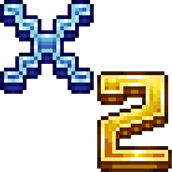

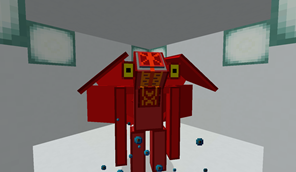
Add a comment